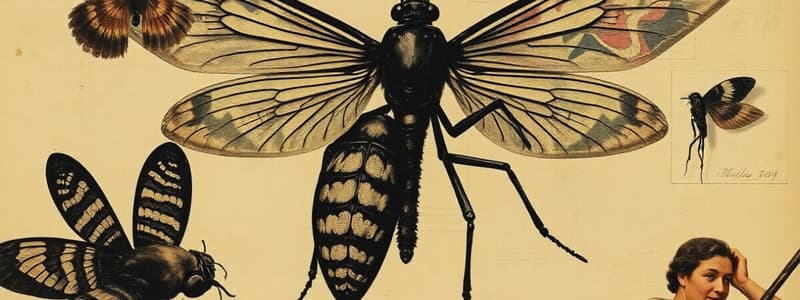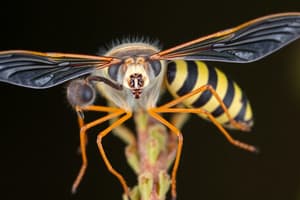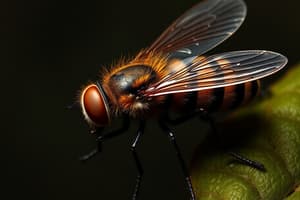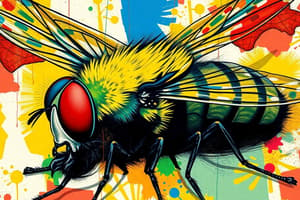Podcast
Questions and Answers
What anatomical feature distinguishes Diptera from other insect orders?
What anatomical feature distinguishes Diptera from other insect orders?
- Possession of 3 pairs of legs.
- Presence of a segmented abdomen.
- The presence of two wings. (correct)
- The presence of antennae.
Which of the following is a characteristic of Diptera?
Which of the following is a characteristic of Diptera?
- They are the most species-poor order of insects.
- They all have aquatic larval stages.
- They are all ectoparasites.
- They are anatomically varied and ecologically exploitive. (correct)
What is the estimated number of described Diptera species worldwide?
What is the estimated number of described Diptera species worldwide?
- 20,000
- 50,000
- 100,000
- 152,000 (correct)
Which statement is most accurate regarding the medical significance of Diptera?
Which statement is most accurate regarding the medical significance of Diptera?
Which of the following conditions is NOT directly associated with Diptera-borne diseases?
Which of the following conditions is NOT directly associated with Diptera-borne diseases?
Which diseases affect half a billion people and have 3.5 billion people rated at risk?
Which diseases affect half a billion people and have 3.5 billion people rated at risk?
How do houseflies contribute to the spread of pathogens?
How do houseflies contribute to the spread of pathogens?
What is the term for flies that produce myiasis?
What is the term for flies that produce myiasis?
Which suborder of Diptera is characterized by mosquitoes with long antennae?
Which suborder of Diptera is characterized by mosquitoes with long antennae?
Which of the following is a characteristic of the suborder Brachycera?
Which of the following is a characteristic of the suborder Brachycera?
What type of development do Diptera exhibit?
What type of development do Diptera exhibit?
Which term describes female dipterans that lay eggs?
Which term describes female dipterans that lay eggs?
What is the term for flies that retain developing larvae within the female's body until pupation?
What is the term for flies that retain developing larvae within the female's body until pupation?
Which term describes the larval stage of mosquitoes and nematocerans?
Which term describes the larval stage of mosquitoes and nematocerans?
What does 'anautogenous' mean in the context of Diptera?
What does 'anautogenous' mean in the context of Diptera?
What is the defining characteristic of autogenous Diptera?
What is the defining characteristic of autogenous Diptera?
What is the primary habitat of crane fly larvae?
What is the primary habitat of crane fly larvae?
How accurate is the statement 'Crane flies bite and feed on blood'?
How accurate is the statement 'Crane flies bite and feed on blood'?
What poses a hazard to automobile travellers?
What poses a hazard to automobile travellers?
In what type of habitat are adult darkwinged fungus gnats typically encountered?
In what type of habitat are adult darkwinged fungus gnats typically encountered?
What role do Chironomid midges have?
What role do Chironomid midges have?
In what areas do biting snipe flies readily attack?
In what areas do biting snipe flies readily attack?
What is the known habit of female Suragina species?
What is the known habit of female Suragina species?
What are the colors of Soldier Fly bodies?
What are the colors of Soldier Fly bodies?
The presence of black soldier larvae in plants can lead to what?
The presence of black soldier larvae in plants can lead to what?
What is a characteristic humpbacked appearance indicative of?
What is a characteristic humpbacked appearance indicative of?
What causes human myiasis?
What causes human myiasis?
What are the typical characteristics of vinegar flies?
What are the typical characteristics of vinegar flies?
What is the typical feeding substrate of Drosophila?
What is the typical feeding substrate of Drosophila?
What kind of flies are commonly found in grasses?
What kind of flies are commonly found in grasses?
What is the main concern with Liohippelates species?
What is the main concern with Liohippelates species?
Which fly-borne disease is transmitted by Psychodidae?
Which fly-borne disease is transmitted by Psychodidae?
Which of the fly-borne diseases are transmitted by Culicidae?
Which of the fly-borne diseases are transmitted by Culicidae?
What is the health related disease that is related to Chloropidae?
What is the health related disease that is related to Chloropidae?
What type of disease are Oestridae related to?
What type of disease are Oestridae related to?
Which family of flies transmits Trypanosomiasis?
Which family of flies transmits Trypanosomiasis?
Which health-related problem is associated with Muscidae?
Which health-related problem is associated with Muscidae?
Which of the following diseases is transmitted by Tabanidae?
Which of the following diseases is transmitted by Tabanidae?
What disease is commonly linked to Simuliidae?
What disease is commonly linked to Simuliidae?
Why are Diptera considered ecologically exploitive insects?
Why are Diptera considered ecologically exploitive insects?
How does the presence of Diptera larvae in aquatic environments affect nutrient cycling?
How does the presence of Diptera larvae in aquatic environments affect nutrient cycling?
How does the life cycle of Diptera that exhibit pupiparity affect their dispersal?
How does the life cycle of Diptera that exhibit pupiparity affect their dispersal?
What implications does black soldier fly (BSF) presence have?
What implications does black soldier fly (BSF) presence have?
What is the relationship between fly breeding strategies and environmental changes?
What is the relationship between fly breeding strategies and environmental changes?
How might climate change influence the distribution and impact of biting midges?
How might climate change influence the distribution and impact of biting midges?
How do the feeding habits of adult Stratiomyidae differ from their larval feeding habits, and what is the significance of this difference?
How do the feeding habits of adult Stratiomyidae differ from their larval feeding habits, and what is the significance of this difference?
What strategy would be effective for minimizing the risk of myiasis from Phoridae flies?
What strategy would be effective for minimizing the risk of myiasis from Phoridae flies?
How do the larval feeding habits of Chloropidae impact agricultural practices?
How do the larval feeding habits of Chloropidae impact agricultural practices?
How can forensic entomologists utilize Diptera in criminal investigations?
How can forensic entomologists utilize Diptera in criminal investigations?
How does the synchronous emergence of Chaoboridae affect lake ecosystems?
How does the synchronous emergence of Chaoboridae affect lake ecosystems?
How does the presence of Chironomidae in water distribution systems pose a challenge to public health?
How does the presence of Chironomidae in water distribution systems pose a challenge to public health?
How do the swarming behaviors of Bibionidae impact agricultural practices?
How do the swarming behaviors of Bibionidae impact agricultural practices?
Considering that only a small fraction of Diptera is medically significant, what broader ecological roles do the majority of Diptera species likely fulfill?
Considering that only a small fraction of Diptera is medically significant, what broader ecological roles do the majority of Diptera species likely fulfill?
What implications does the existence of autogenous Diptera have for disease transmission?
What implications does the existence of autogenous Diptera have for disease transmission?
Flashcards
What are Diptera?
What are Diptera?
The order Diptera refers to true flies.
What are the 2 suborders of Diptera?
What are the 2 suborders of Diptera?
The two suborders of Diptera are Nematocera and Brachycera.
What does Diptera mean?
What does Diptera mean?
This term means “two-winged”.
Impact of bloodsucking/myiasis flies?
Impact of bloodsucking/myiasis flies?
Signup and view all the flashcards
What is Pupiparous?
What is Pupiparous?
Signup and view all the flashcards
Diseases caused by flies?
Diseases caused by flies?
Signup and view all the flashcards
Are Diptera holometabolous?
Are Diptera holometabolous?
Signup and view all the flashcards
What is Anautogenous?
What is Anautogenous?
Signup and view all the flashcards
What is Autogeny?
What is Autogeny?
Signup and view all the flashcards
How many observable instars do Muscoid Diptera pass through?
How many observable instars do Muscoid Diptera pass through?
Signup and view all the flashcards
What family does Tipulidae include?
What family does Tipulidae include?
Signup and view all the flashcards
What family does Bibionidae include?
What family does Bibionidae include?
Signup and view all the flashcards
What family does Mycetophilidae include?
What family does Mycetophilidae include?
Signup and view all the flashcards
What family does Psychodidae include?
What family does Psychodidae include?
Signup and view all the flashcards
What family does Chaoboridae include?
What family does Chaoboridae include?
Signup and view all the flashcards
What family does Corethrellidae include?
What family does Corethrellidae include?
Signup and view all the flashcards
What family does Culicidae include?
What family does Culicidae include?
Signup and view all the flashcards
What family does Simuliidae include?
What family does Simuliidae include?
Signup and view all the flashcards
What family does Ceratopogonidae include?
What family does Ceratopogonidae include?
Signup and view all the flashcards
What family does Chironomidae include?
What family does Chironomidae include?
Signup and view all the flashcards
What family does Tabanidae include?
What family does Tabanidae include?
Signup and view all the flashcards
What family does Rhagionidae include?
What family does Rhagionidae include?
Signup and view all the flashcards
What family does Athericidae include?
What family does Athericidae include?
Signup and view all the flashcards
What family does Stratiomyidae include?
What family does Stratiomyidae include?
Signup and view all the flashcards
What family does Syrphidae include?
What family does Syrphidae include?
Signup and view all the flashcards
What family does Phoridae include?
What family does Phoridae include?
Signup and view all the flashcards
What family does Chloropidae include?
What family does Chloropidae include?
Signup and view all the flashcards
What family does Piophilidae include?
What family does Piophilidae include?
Signup and view all the flashcards
What family does Drosophilidae include?
What family does Drosophilidae include?
Signup and view all the flashcards
What family does Muscidae include?
What family does Muscidae include?
Signup and view all the flashcards
What family does Glossinidae include?
What family does Glossinidae include?
Signup and view all the flashcards
What family does Hippoboscidae include?
What family does Hippoboscidae include?
Signup and view all the flashcards
What family does Nycteribiidae include?
What family does Nycteribiidae include?
Signup and view all the flashcards
What family does Streblidae include?
What family does Streblidae include?
Signup and view all the flashcards
What family does Oestridae include?
What family does Oestridae include?
Signup and view all the flashcards
What family does Calliphoridae include?
What family does Calliphoridae include?
Signup and view all the flashcards
What family does Sacrophagidae include?
What family does Sacrophagidae include?
Signup and view all the flashcards
Which fly transmits Bartonellosis?
Which fly transmits Bartonellosis?
Signup and view all the flashcards
Which fly transmits Leishmaniasis?
Which fly transmits Leishmaniasis?
Signup and view all the flashcards
Which fly transmits Filariasis?
Which fly transmits Filariasis?
Signup and view all the flashcards
Which fly transmits Malaria?
Which fly transmits Malaria?
Signup and view all the flashcards
Which fly transmits Zika?
Which fly transmits Zika?
Signup and view all the flashcards
Which fly transmits Onchocerciasis?
Which fly transmits Onchocerciasis?
Signup and view all the flashcards
Study Notes
- The Diptera order, or true flies, is the largest and most diverse order of insects, anatomically varied, and ecologically exploitive
- Diptera means "two-winged" referring to having two wings
- Worldwide, there are at least 152,000 species described
- The Nearctic Region contains around 20,000 Dipteran species.
- Diptera can impact on human and animal health, with only a small fraction of the species having medical significance.
- Diptera also includes Mosquitoes to wingless ectoparasites
- Diptera can transmit Malaria, encephalitis, yellow fever, human filariasis, and Zika
Culicidology
- Malaria, Filariasis, Leishmaniasis, and onchocerciasis are diseases which affect half a billion humans with 3.5 billion rated at risk
- Mosquitoes, blackflies, and biting midges annoy outdoor enthusiasts and livestock, pets, and other domestic, and wild animals.
- Filth flies found near cattle, hog, and poultry operations can annoy residents and are often the focus of litigation
- Medicocriminal or forensic entomology includes flies (Diptera)
Fly Facts
- Ubiquitous species like the housefly can act as effective mechanical vectors of pathogens in enteric diseases
- The depredation of bloodsucking and myiasis-producing flies cause adverse effects on animal agriculture
- Diptera can be divided into two suborders Nematocera (mosquitoes-long antennae) and Brachycera (horse flies, deer flies-short antennae)
- Genetic, molecular, morphological, and paleontological datasets show that "Nematocera" is a paraphyletic group of superficially similar lineages
- Hematophagy arose within Diptera in 12 separate occasions.
- Larval endo-parasitism and Ecto-parasitism occurred 17 and 10 times relatively
- The loss of functional wings occurred 18 times.
Diptera Life History
- The Diptera are holometabolous (complete metamorphosis)
- Most dipteran females lay eggs (Oviparous)
- Other diptera are oviviviparous, hatching eggs internally (larviparous), e.g. flash flies (Sarcophagidae).
- Pupiparous flies will retain developing larvae until they pupate, e.g., louse flies (Hippoboscidae)
- Immature fly stages often colonize aquatic or semi-aquatic habitats, including mosquitoes, black flies, most deer flies and horse flies
- Mosquitos and most other nematocerans have 4 larva, instars
- Muscoid Diptera pass through three observable instars.
- Anautogenous diptera require a blood meal for egg laying
- Autogenous flies produce an initial egg batch before needing a blood meal.
- Adaptations among early aquatic instars depend on cuticular respiration
- The later instars generally respire via gills or have various adaptations that permit them to obtain atmospheric air.
- Mosquito larvae are highly adapted to their environment
- Air-breathing lower Diptera hang from the water's surface by respiratory siphons or specialized abdominal setae
Diptera Adult Features
- Nematocera have elongate, filamentous antennae composed of six or more segments.
- Nematocera antennae are longer than the head and thorax combined.
- Simuliidae have short and compact antennae.
Fly Behaviors
- Titer in CO2 is an olfactory cue for recognizing hosts, additional cues are mercaptans, octanol, and lactic acid
- Some flies also use visual cues for host selection
- K-strategists, such as tsetse flies and sheep keds, have longer life cycles, produce fewer offspring, and are influenced by density-dependent mortality factors
- R-strategists produce a large number of offspring, where each individual's survival chance is relatively small
- R-Strategists feature rapid growth, a short life cycle, and are influenced by a high mortality-density independent factor example being: house flies and certain mosquito
Crane Flies and March Flies
- Crane Flies are attracted to light and mistaken for large mosquitoes
- Crane Flies feed on nectar
- Crane Flies do not bite or feed on blood
- The Crane Fly family is Cosmopolitan with 60 genera and 1500 species in North America, and they have aquatic and semi-aquatic habitats.
- March Flies(Bibionidae) adults emerge in the spring and feed on flower nectar and pollen
- March Fly larvae are scavengers found in decaying organic materials like forest litter, manure, and humus-rich soils.
- March Fly larvae can damage cultivated plants, such as cereal and grass crops.
- Adults of the Love-bug (Plecia nearctica) emerge on the Gulf and south Atlantic coasts (May-September)
- Abundant flying March Fly pairs can pose a hazard to automobile travelers
Fungus Gnats and Phantom Midges
- Darkwinged Fungus Gnats (Sciaridae) are encountered in moist, and shady habitats.
- Fungus Gnat larvae feed on fungi, decaying plants, soybean, and clovers.
- Sciarids pose no medical problems, with rare reports of illness in pets after eating adults
- There are more than 100 Nearctic Fungus Gnat species
- Phantom Midges (Chaoboridae) are mosquito-like, but lack an elongate proboscis and abundant wing scales
- Phantom Midge eggs hatch within 2-4 days and are laid on the water surface
- Phantom Midge larval stage averages 15-32 days, and the pupa lasts 3-6 days actively
- Larvae are aquatic and transparent inhabiting large lakes, small pools, bogs, and small ponds
- The clear lake gnat is an inhabitant of large lakes and impoundments in the western USA
- Large numbers of Phantom Midges emerge synchronously in the spring, causing annoyance in residential and resort areas because of light attraction
Chironomid Midges
- Chironomid midges are mistaken for mosquitoes, but lack the blood-sucking proboscis
- Chironomid midges have slender legs, narrow scaleless wings, and plumose antennae in adult males
- Chironomid midges lack a long proboscis for feeding on blood, but are able to imbibe honeydew and other natural sugars
- Some midges take no food at all as adults
- Chironomid larvae are aquatic and create tubes or attach to substrates in different bodies of water
- It inhabits rivers, streams, lakes, ponds, water supplies, and sewage systems, and are the most abundant benthic organisms
- Common issues can arise from inhabitants developing allergies to the larval hemoglobin
- They cause annoyance to humans and cause economic damage to machinery, paint finishes, automobiles, and airplanes.
- The bacterium Vibrio cholerae has been isolated from chironomid egg masses
- Large numbers of adult midges can discourage tourism and contaminate materials, especially in pharmaceutical, food processing ,and manufacturing plants.
- The fly larvae can pass through taps into homes within water-storage and water distribution
Snipe Flies and Athericid Flies
- Snipe Flies (Rhagionidae) mostly prey on other insects
- In California Snipe Fly adults are active from April to July and readily attack domestic animals and mammals
- Snipe Flies inflict painful bites around heads, but they have not been implicated in transmitting disease agent
- Snipe Fly biting activity occurs in Yellowstone National Park, starting in early July and continuing till early September including a swarms that attack along trails
- Athericidae (Athericid flies) inhabit flowing water and predate on other insect larvae and have one generation per year
- Female Suragina species suck human and domestic animal blood as well as cold-blooded vertebrates.
- Six Nearctic Athericid species are present in Texas and Mexico, three being blood feeding genus suragina
Soldier Flies and Hunchback Flies
- Soldier Flies (Stratiomyidae) can have colored bodies(yellow, green, blue, or black) and also be of metallic appearance.
- Soldier fly adults visit flowers, cattails, and other emergent aquatic vegetation.
- Black soldier fly can become abundant in sewer processing plants with trickle filters, enough to block the system.
- Black soldier fly larvae can help in house fly control and reduction of pathogens, especially in manure
- Black soldier fly larvae can be consumed by humans through over ripe fruit or undercooked meat, resulting in intestinal myiasis
- Hunchback (Phoridae) appearance is characteristic and humpbacked
- Hunchback Flies (Phoridae) run in short, quick bursts and are found in damp places near larval habitats
- Hunchback Fly habitats are extremely varied
- Hunchback larvae arrive late on decomposing bodies
- Megaselia scalaris, a species of humpbacked fly, is of noteworthy medical importance
- The laying of eggs takes place in decaying plants and animal waste such as dead insects, bird nets, sewage treatment beds, and commercial mushrooms
- Females lays eggs in fruits, decaying plants/or waste
- In humans they can cause cutaneous pneumonic, nasal, ophthalmomyiasis
Hover Flies, Skipper Flies and Fruit Flies
- Flower Flies (Syrphidae) are strong fliers that hover near nectar flowers
- They do not bite/ sting
- Syrphidae larvae inhabit social insects, various feeding habits
- Syrphidae are found in wastewater lagoons for livestock
- Syrphidae occasionally, E. tenax cause gasterointenstinal and urogenital myiasis
- The number of species are more than 900
- Skipper Flies live in a variety of dead plant and animal material, including food
- Skipper Flies are pests in stored cheeses
- Skipper Flies are consumed by humans and cause gastrointestinal distress
- Small Fruit Flies (Drosophilidae) have red eyes, and they have stalked posterior spiracles
- Fruit flies colonize decaying vegetation such as fruits, plants,sap, and fungi. Drosphilidae feed on the decaying substrate with yeast
Grass Flies
- Grass Flies (Chloropidae have adults that are commonly found in grasses and other low vegetation, or visiting flowers
- Larvae lack an apparent head
- Most larvae are phytophagous
- Grass Flies are attracted to humans and other mammals
- Liohippelates, eye gnats, species have resulted in mechanical transmission in livestock/mammals
- There are approximately 270 species in the Nearctic region
Zoonotic Diseases
- One Health is an approach which requires collaboration across disciplines and sectors, promoting the best health outcomes for animals, plants, and the environment
- One Health aims at achieving optimal health outcomes recognizing the interconnection between people, animals, plants, and their shared environment
- Changes to human populations, climate and land use, and international travel and trade have caused new/emerging or existing zoonotic diseases
- Zoonotic diseases are those which are transmitted to animals from people or vice versa
- Zoonotic diseases include: rabies, salmonella infection, west nile virus, Q Fever(Coxiella burnetii), Anthrax, Brucellosis, Lyme disease, Ringworm, and Ebola
- Germs(Zoonoses) can be transmitted through direct/indirect contact, and exposure to vectors, food/water contamination
- "One Health" addresses issues such as zoonotic diseases, antimicrobial resistance, food saftey, food security, and environmental contamination
- One Health is a collaboration of human health, animal health, environment heath and more between sectors of law, policy,community and pet care
Studying That Suits You
Use AI to generate personalized quizzes and flashcards to suit your learning preferences.




